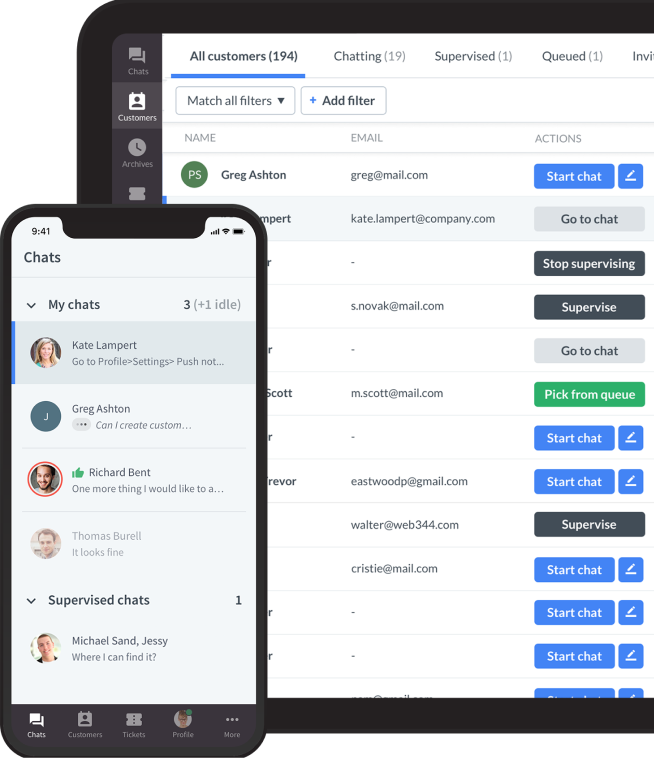Showing top 0 results 0 results found
Showing top 0 results 0 results found

When it comes to customer service, what’s more frustrating than having to start a chat all over again because you accidentally closed a tab? I mean, besides waiting 15 minutes in a queue to talk to a CS agent?
If there’s anything that could bring comfort in such situations, it’s asynchronous messaging. That’s how we’ve been communicating in our private lives for quite some time now. And that’s how customers expect to communicate with business brands. Who can blame them? After all, have you ever lost a chat session while solving a client case?
Read on to find out how to use asynchronous messages in customer service.
Synchronous messaging vs asynchronous messaging
To better grasp the concept of asynchronous communication, let’s define the differences between synchronous and asynchronous messaging.
Synchronous messaging happens when two parties are present and communicate concurrently and simultaneously. A customer reaches out with a question or wants to solve an issue, you have a synchronous chat, and the conversation ends when their needs are met. In this case, both sides are paying attention at the same time. There’s also a clearly defined beginning and end to the interaction.
The most popular synchronous messaging examples are phone calls, Zoom, Meet, and chats in real-time.
Asynchronous messaging (or async messaging) gives participants the freedom to start, pause, and resume the conversation on their own terms. A customer can send a message when there’s no agent available on chat, leave the website, and read an agent’s reply when they return to the site. It all happens at a convenient time for customers, and no one expects an immediate response.
Customers don’t need to stay at a computer in a dedicated session to send or receive messages. They can close the tab on purpose! Just like they close messaging apps such as: Facebook Messenger or WhatsApp after they send a message to a friend. Both of these are the prime examples of messaging platforms we’ve used for years. Other popular asynchronous messaging examples are emails, forum threads and comments, project management tools such as Asana or Trello boards, Slack, and messaging mode in live chat.
Let’s see what kind of benefits asynchronous messaging gives you in customer service.
The pressure is off - the benefits of asynchronous messaging
Asynchronous communication takes away the stress of an immediate response. When we have time to think about our answers, it helps to create more balanced and thoughtful responses. That’s convenient for both parties, but there’s so much more to it. Here’s how asynchronous messages can help customer service agents deliver a better customer experience.
The ability to connect 24/7
“We’re offline right now. Please reach out tomorrow.” This kind of notification will soon be a relic of the past. Companies will strive to allow customers to connect 24/7 with the help of chatbots, self-service tools, or asynchronous messaging. With async messaging, customers can start a chat even when all the agents are offline. They can leave a website and read a reply when they’re back on the site or get a notification via email on mobile.
Messaging mode with a history inside live chat
Synchronous communication requires customers to be present in real-time while solving their cases. Often, a disconnected chat session means starting the explanation of their issue from the beginning, sometimes to a different agent.
With asynchronous communication in LiveChat, a saved chat history is always visible for both parties, because it works independently of the device or session. Clients don’t need to worry about the time. They can pause the conversation and initiate it whenever it’s convenient for them. Agents never lose the context of the case, and users don’t need to repeat themselves. They continue the conversation, even when a customer comes back with a new question after a few months. Find out how to make the most out of messaging mode in LiveChat.
No need for an immediate response to complex issues
Complex issues sometime require more time from customer service agents. They need to consult the case with teammates from other departments or check the technical aspects of the app. With asynchronous messaging, people don't need to be tethered to their devices, waiting for the issue to be solved.
Increased number of solved cases
With synchronous chats, when there are multiple people requiring help, agents struggle to respond. This could lead to longer wait times, queues, and, as a result, chat drop-offs. Every missed chat is a lost business opportunity. With asynchronous messaging, customers can see the information about your inability to respond immediately, leave a message, and get a notification as soon as you reply. Agents can then prioritize urgent chats and handle the rest of the messages later on.
More business opportunities and trust around the globe
Brands sell their products worldwide, so why should they limit their support hours only to the business hours in their country? Not all of them can afford to have a support team working 24/7. That’s why asynchronous messaging that allows customers to leave their questions in the chat is a game changer for them.
Gen Z and text-based communication
Besides “when” and “how” to communicate, there’s also another part of the equation that makes for excellent customer service. It’s “where” to contact them - anywhere your customers are.
It’s especially important with younger generations, like Gen Z, who look for a seamless omnichannel experience. Usually, while shopping, they jump between devices and platforms, and they expect the possibility to pick up a conversation with you anywhere they are, without any hassle.
According to the Gen Z Communication Trends Report by LiveChat: “The average number of chats in June 2022 doubled compared to 1460 chats in the corresponding period. This is also due to Gen Z’s preference for text-based communication, and we should be seeing an additional increase as more Gen Zers get purchasing power.”
Even if Gen Z is not the main generation you’re targeting right now, they’ll become a major purchasing power you won’t be able to ignore over the next couple of years. Young students and professionals already boast $360 billion in disposable income.
So, what is the best communication method for those digital natives across different communication channels?
Turn Gen Z visitors into customers.
Free 14-day trial Omnichannel messaging

Omnichannel presence
One way to keep up with Gen Z is to gather all the incoming inquiries from social media platforms in one place, such as LiveChat. The way it works is simple. Your Facebook fans contact you via Messenger, you see a question from them inside LiveChat, and you answer them right from there. This way, agents can handle many inquiries from various platforms in one place. It makes customer service agents’ jobs easier and helps your business provide more ways of contact.
According to the report: “Your Gen Z customers will appreciate having more ways to communicate with you, and you'll be able to handle them all in one place without compromising your first response time.”
If you want to win Gen Z over, doing your best to deliver stellar customer service across different platforms is a no-brainer. Find out more about how Gen Z will shape the future of communication from our report.
Keep focus on customers with async communication
While async messaging gives your agents more time to handle cases, you shouldn’t push it too far. The work support teams do should be designed around the customers’ needs, so that agents are waiting for the reply from customers, not the other way around.
First response time and handling cases in a short amount of time are still important metrics. You should plan enough agents on the chat to avoid unresolved cases that drag for days. You don’t want to treat asynchronous chat like an email or a ticket. Make sure agents focus on having multiple chats at once from different apps, while clients can be more flexible with the responses.
While we forgive our friends' long response time, we’re never as forgiving with brands. After all, we can find another online store with just a few clicks. So let your customers close a chat while waiting for a reply, but do your best to make sure they return.








Comments